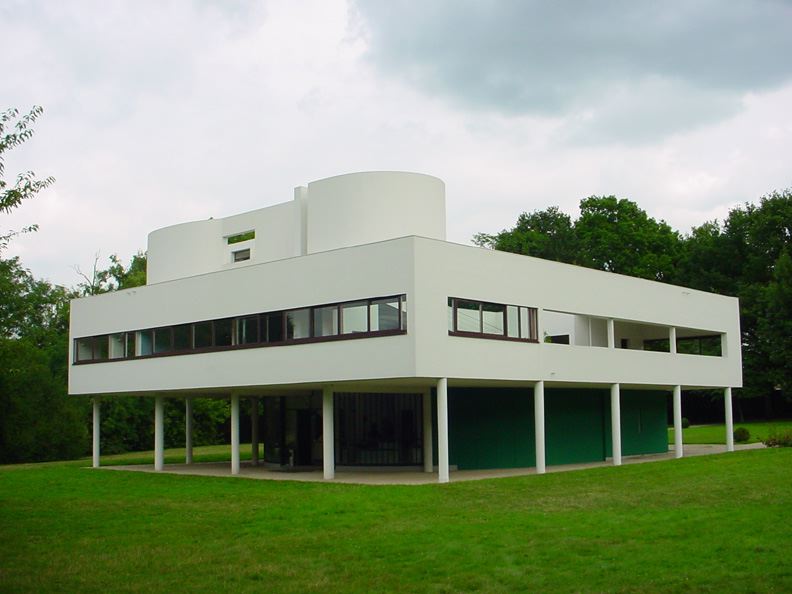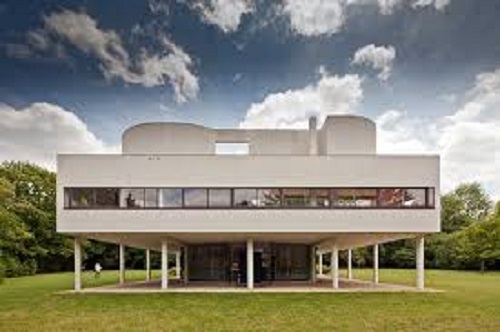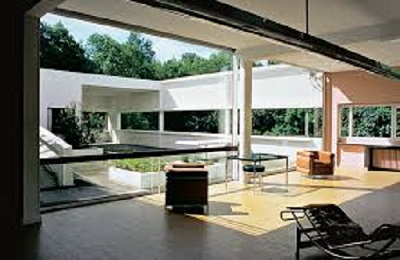Villa Savoye
Contents |
[edit] Introduction
Villa Savoye is a modernist villa designed by the architect Le Corbusier. Located in Poissy, on the outskirts of Paris, it is representative of Le Corbusier’s ‘five points’ of new architecture and is one of the most iconic examples of the International Style.
The Savoye family approached Corbusier about building a country home in early-1928. He agreed and set about the project as a demonstration of his theory that the home should be a ‘machine for living in’, with the functions of everyday life becoming critical to its design. The spatial planning was inspired by the designs of new automobiles and trans-Atlantic steamships, with spaces arranged to maximise efficiency and express a minimalistic aesthetic.
The building is currently a popular tourist attraction and, in July 2016, was inscribed as a UNESCO World Heritage Site.
[edit] Design and construction
Corbusier's ‘Five Points’ were the basis for his new modernist ideas of aesthetics:
- Elevation of the building from the ground using the support of ground-level pilotis.
- Functional roof, reclaiming the land occupied by the building.
- Floor plan free of load-bearing walls, instead placing walls freely as desired aesthetically.
- Long horizontal windows.
- Freely-designed facades unconstrained by load-bearing considerations.
Point 1 gives the building the impression of floating above the ground. The ground floor has a curved form that is influenced by the movement of the cars, and is based on an orthogonal grid of concrete pillars spaced 4.75 m apart, with the main part of the villa above.
The free floor plan (point 3) enables occupants to meander between spaces, with a series of ramps moving from the lower level up to the rooftop garden.
It was built using reinforced concrete, with plastered walls and iron handrails. Corbusier used horizontal ribbon windows similar to his earlier villas. However, he chose to use timber windows as opposed to the more common metal ones. This was because the set-back position of the glass in the timber frame gave the impression of the façade being a series of parallel planes.
The basic house was constructed within a year, although it was not until 1931 that it was fit for habitation.
[edit] Post-completion
The house was inhabited by the Savoye family for a short period after it was completed. However, it was abandoned after the German invasion of France in 1940 during which time it incurred considerable damage.
In 1958, it became the property of the French state and was initially scheduled for demolition. After much outcry however, including from Le Corbusier himself, it was designated an official French historical monument in 1965, the only building of the architect’s to be recognised as such during his lifetime.
The architect Jean Debuisson began a renovation attempt in 1963, although it wasn’t until 1985 that thorough works began, which were completed in 1997. The works included structural and surface repairs to the facades and terraces, installation of lighting and security features, and reinstatement of some original fixtures and fittings.
As one of the most significant contributions to modern architecture in the 20th century, Villa Savoye is now a museum, receiving thousands of visitors each year.
[edit] Related articles on Designing Buildings Wiki
- 2 Willow Road.
- Art Deco.
- Building of the week series.
- Casa Mila.
- Cite Radieuse.
- Concept architectural design.
- Constructivist architecture.
- Eiffel Tower.
- Fallingwater.
- Guggenheim Museum, Bilbao.
- Le Corbusier.
- Notre Dame du Haut.
- Pilotis.
- The Louvre.
- Vernacular architecture.
[edit] External resources
- Villa Savoye - Official site
- ArchDaily - Villa Savoye
Featured articles and news
A change to adoptive architecture
Effects of global weather warming on architectural detailing, material choice and human interaction.
How big is the problem and what can we do to mitigate the effects?
Overheating guidance and tools for building designers
A number of cool guides to help with the heat.
The UK's Modern Industrial Strategy: A 10 year plan
Previous consultation criticism, current key elements and general support with some persisting reservations.
Building Safety Regulator reforms
New roles, new staff and a new fast track service pave the way for a single construction regulator.
Architectural Technologist CPDs and Communications
CIAT CPD… and how you can do it!
Cooling centres and cool spaces
Managing extreme heat in cities by directing the public to places for heat stress relief and water sources.
Winter gardens: A brief history and warm variations
Extending the season with glass in different forms and terms.
Restoring Great Yarmouth's Winter Gardens
Transforming one of the least sustainable constructions imaginable.
Construction Skills Mission Board launch sector drive
Newly formed government and industry collaboration set strategy for recruiting an additional 100,000 construction workers a year.
New Architects Code comes into effect in September 2025
ARB Architects Code of Conduct and Practice available with ongoing consultation regarding guidance.
Welsh Skills Body (Medr) launches ambitious plan
The new skills body brings together funding and regulation of tertiary education and research for the devolved nation.
Paul Gandy FCIOB announced as next CIOB President
Former Tilbury Douglas CEO takes helm.
UK Infrastructure: A 10 Year Strategy. In brief with reactions
With the National Infrastructure and Service Transformation Authority (NISTA).
Ebenezer Howard: inventor of the garden city. Book review.
Airtightness Topic Guide BSRIA TG 27/2025
Explaining the basics of airtightness, what it is, why it's important, when it's required and how it's carried out.
























